display Lancia Thesis 2006 Owner handbook (in English)
[x] Cancel search | Manufacturer: LANCIA, Model Year: 2006, Model line: Thesis, Model: Lancia Thesis 2006Pages: 386, PDF Size: 8.69 MB
Page 155 of 386

154
When a combined function is set, if
a button is pressed the main func-
tion of the button pressed is activat-
ed, together with those already set. If
the button corresponding to a func-
tion which is already on is pressed,
such function will be cancelled (the
related led turns off).
Press the AUTObutton to restore
air distribution control after a man-
ual setting.
When the driver selects the air dis-
tribution to the windscreen, also the
passenger side air flow is automati-
cally directed to the windscreen.
Anyway, the passenger can select
another air distribution pattern, by
pressing the related buttons.Buttons for adjusting rear air
distribution (6, 9 fig. 122)
When the back control panel is
activated, it is possible to set one of
the three air distribution patterns for
the passenger compartment back
area by pressing the related buttons:
DAir flow to back central vents.
SAir flow to rear footwells. This air
distribution pattern, due to the nat-
ural tendency of heat to move
upwards, offers a prompt feeling of
warmth to the coolest parts of the
body.
SD
Air flow shared between rear
footwell vents (warmer air) and cen-
tral rear vents (cooler air).
Air distribution setting is displayed
when leds relevant to the selected
button are lit, which will be turned
off in case of fully automatic opera-
tion (FULL AUTO). When a combined function is set, if
a button is pressed the main func-
tion of the button pressed is activat-
ed, together with those already set. If
the button corresponding to a func-
tion which is already on is pressed,
such function will be cancelled (the
related led turns off).
Press the AUTObutton to restore
air distribution control after a man-
ual setting.
Page 156 of 386

155
Buttons for adjusting fan speed
(13, 14 fig. 121 – 7, 8 fig. 122)
Press respectively front control
buttons 13or 14 (fig. 121) and back
control buttons 8or 7 (fig. 122) to
increase or decrease the fan speed so
to adjust the amount of air let into
the passenger compartment while
keeping the required temperature
constant.
The fan speed is indicated by the
bars which light up on the front dis-
play 5 (fig. 121) and rear display 3
(fig. 122), when the back control
panel is active. Repeatedly press
button or keep pressed 13 (fig. 121)
or 8(fig. 122) to switch the fan on
at top speed (all bars on).
Repeatedly press or keep pressed
button 14(fig. 121) or 7(fig. 122)
to switch the fan on at minimum
speed (one bar on).When the fan minimum speed is
set up (one bar on), by keeping
pressed for at least two seconds but-
ton 14(fig. 121) or 7(fig. 122), the
climate control system is deactivated
and all the fan bars on the display
turn off; OFFmessage is displayed.
The fan speed can be adjusted
manually through both the front
control panel and the rear control
panel, but it is the same one for the
whole passenger compartment.
IMPORTANTPress the AUTO
button to restore air distribution
control after a manual setting.AUTO buttons
(automatic operation)
(1, 9 fig. 121 - 5 fig. 122)
Press the AUTObutton on the dri-
ver side and/or front/back-seat pas-
senger side: the system will automat-
ically control the air amount and
distribution pattern in the related
passenger compartment areas and
will cancel all the previously made
settings. This condition is marked by
the message FULL AUTOon the
system front and rear display,
besides the leds on the air distribu-
tion buttons turning off.
If one of the functions automatical-
ly controlled by the system (air recir-
culation, air distribution, fan speed
or air conditioner compressor deacti-
vation) is manually adjusted, the
message FULLon the display turns
off to indicate that the system is no
longer controlling the functions inde-
pendently (apart from temperature
control that is always automatic).
Page 158 of 386

The climate control system can be
deactivated also by the rear control
panel, when operating: press repeat-
edly or keep pressed button 7 (fig.
122) until all the fan bars on the dis-
play turn off and message OFFis
displayed.
To exclude the rear control panel,
press again button REAR; the but-
ton led turns off and the front-seat
passenger’s controls are operating
again.
Air recirculation on/off button
(3 fig. 121)
The air recirculation function is
controlled according to three strate-
gies:
– automatic operation (button left
led on);
– forced ventilation on (recircula-
tion always on), the right led on the
button will come on;– forced deactivation off (recircula-
tion always off, air taken from the
outside), both leds on the button will
go off.
The three conditions are obtained
by pressing the air recirculation but-
ton 3in sequence.
When the air recirculation function
is automatically controlled by the
system, the left led on the air recir-
culation button is turned on, while
the right led is on or off according to
the actual recirculation conditions
(on or off).
During automatic operation, the
recirculation function is automati-
cally switched on when the pollution
sensor detects the presence of pollut-
ed air, e.g. in cities, queues, tunnels
and during windscreen wiper opera-
tion (due to the characteristic smell
of alcohol). In addition, if the compressor is on
and the outside temperature is over
5 °C, to prevent air polluted by
exhaust gases getting inside the pas-
senger compartment during stops,
the system stops air recirculation
when the car speed is lower than 6
km/h. When the car speed returns
over 12 km/h, the system restores
the previous conditions.
After using the air recirculation
function for a long time (over 15
consecutive minutes), the system
automatically stops it for safety rea-
sons, thus letting air be changed.
When air recirculation manual
control is set (button left led off),
message FULLon the display is off.
157
Page 159 of 386

158
IMPORTANTAir at a temperature
lower than that of the outside air
cannot be let in to the passenger
compartment when the compressor
is off. Furthermore, in particular
environmental conditions, the win-
dows could mist up fast because the
air is no longer dehumidified.
The setting will be stored when the
engine is stopped. Either press √
button again or press the AUTObut-
ton to reset automatic control of the
compressor (in the latter case, the
manual settings will be cancelled).
The led on the √button will go out. IMPORTANTThe air recircula-
tion function will allow, according to
the system operation (i.e. heating or
cooling) to reach the required condi-
tions faster. We recommend not
turning on this function on rainy
and/or cold days as this will consid-
erably increase window misting,
especially if the climate control sys-
tem is off.
In particular climate
conditions (e.g. low out-
side temperature or high
humidity) and with the inside air
recirculation automatic control
on, windows could start misting
up. In this case, press the air
recirculation button and set it to
forced open position (both button
leds off), and increase air flow to
the windscreen, if required.Climate control system
compressor off button (7 fig. 121)
Press the √button, when the but-
ton led is on, to switch the air condi-
tioner compressor off. The led will
go off. By pressing again the button
when the led is off, the system auto-
matic control of the compressor acti-
vation is restored; this situation is
indicated by button led lighting up.
When the air conditioner compres-
sor is off, if the system is no longer
able to keep the requested tempera-
ture, the message FULL AUTOon
the display turns off and the system
deactivates air recirculation to pre-
vent window misting up. Instead, if
the system is still able to maintain
the requested temperature, the mes-
sage FULLon the display will stay
on.
Page 160 of 386
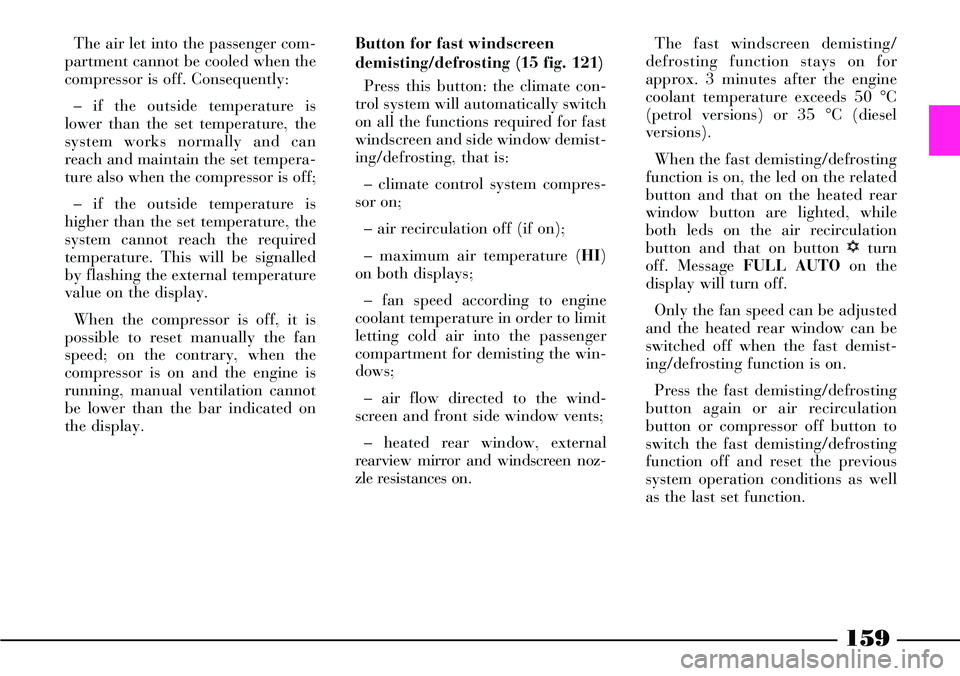
159
The air let into the passenger com-
partment cannot be cooled when the
compressor is off. Consequently:
– if the outside temperature is
lower than the set temperature, the
system works normally and can
reach and maintain the set tempera-
ture also when the compressor is off;
– if the outside temperature is
higher than the set temperature, the
system cannot reach the required
temperature. This will be signalled
by flashing the external temperature
value on the display.
When the compressor is off, it is
possible to reset manually the fan
speed; on the contrary, when the
compressor is on and the engine is
running, manual ventilation cannot
be lower than the bar indicated on
the display. Button for fast windscreen
demisting/defrosting (15 fig. 121)
Press this button: the climate con-
trol system will automatically switch
on all the functions required for fast
windscreen and side window demist-
ing/defrosting, that is:
– climate control system compres-
sor on;
– air recirculation off (if on);
– maximum air temperature (HI)
on both displays;
– fan speed according to engine
coolant temperature in order to limit
letting cold air into the passenger
compartment for demisting the win-
dows;
– air flow directed to the wind-
screen and front side window vents;
– heated rear window, external
rearview mirror and windscreen noz-
zle resistances on.The fast windscreen demisting/
defrosting function stays on for
approx. 3 minutes after the engine
coolant temperature exceeds 50 °C
(petrol versions) or 35 °C (diesel
versions).
When the fast demisting/defrosting
function is on, the led on the related
button and that on the heated rear
window button are lighted, while
both leds on the air recirculation
button and that on button √turn
off. Message FULL AUTOon the
display will turn off.
Only the fan speed can be adjusted
and the heated rear window can be
switched off when the fast demist-
ing/defrosting function is on.
Press the fast demisting/defrosting
button again or air recirculation
button or compressor off button to
switch the fast demisting/defrosting
function off and reset the previous
system operation conditions as well
as the last set function.
Page 161 of 386
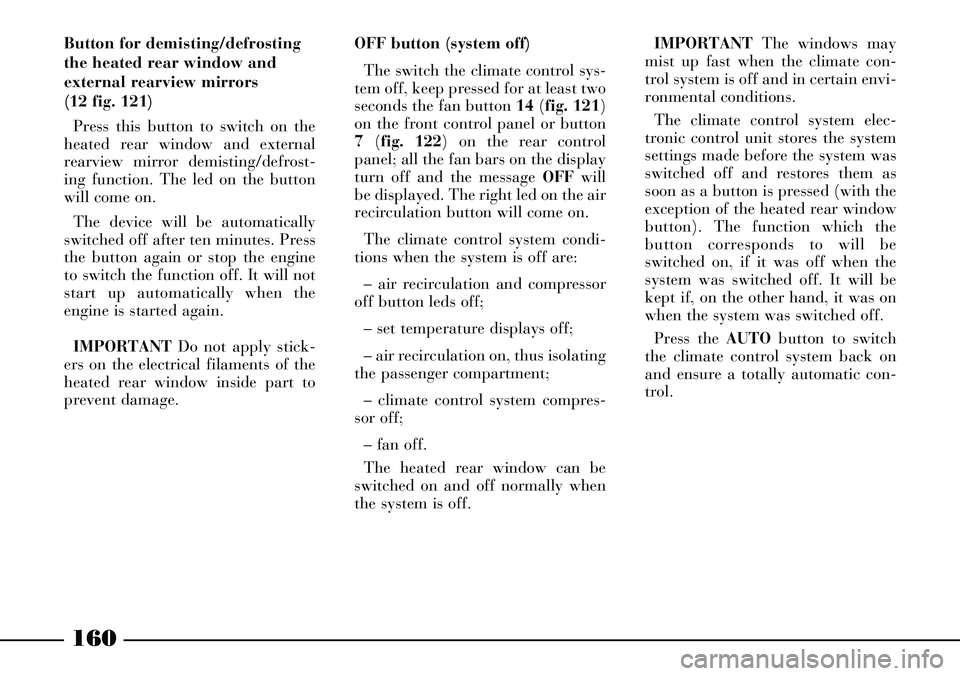
160
Button for demisting/defrosting
the heated rear window and
external rearview mirrors
(12 fig. 121)
Press this button to switch on the
heated rear window and external
rearview mirror demisting/defrost-
ing function. The led on the button
will come on.
The device will be automatically
switched off after ten minutes. Press
the button again or stop the engine
to switch the function off. It will not
start up automatically when the
engine is started again.
IMPORTANTDo not apply stick-
ers on the electrical filaments of the
heated rear window inside part to
prevent damage.OFF button (system off)
The switch the climate control sys-
tem off, keep pressed for at least two
seconds the fan button 14 (fig. 121)
on the front control panel or button
7 (fig. 122) on the rear control
panel; all the fan bars on the display
turn off and the message OFFwill
be displayed. The right led on the air
recirculation button will come on.
The climate control system condi-
tions when the system is off are:
– air recirculation and compressor
off button leds off;
– set temperature displays off;
– air recirculation on, thus isolating
the passenger compartment;
– climate control system compres-
sor off;
– fan off.
The heated rear window can be
switched on and off normally when
the system is off.IMPORTANTThe windows may
mist up fast when the climate con-
trol system is off and in certain envi-
ronmental conditions.
The climate control system elec-
tronic control unit stores the system
settings made before the system was
switched off and restores them as
soon as a button is pressed (with the
exception of the heated rear window
button). The function which the
button corresponds to will be
switched on, if it was off when the
system was switched off. It will be
kept if, on the other hand, it was on
when the system was switched off.
Press the AUTObutton to switch
the climate control system back on
and ensure a totally automatic con-
trol.
Page 164 of 386
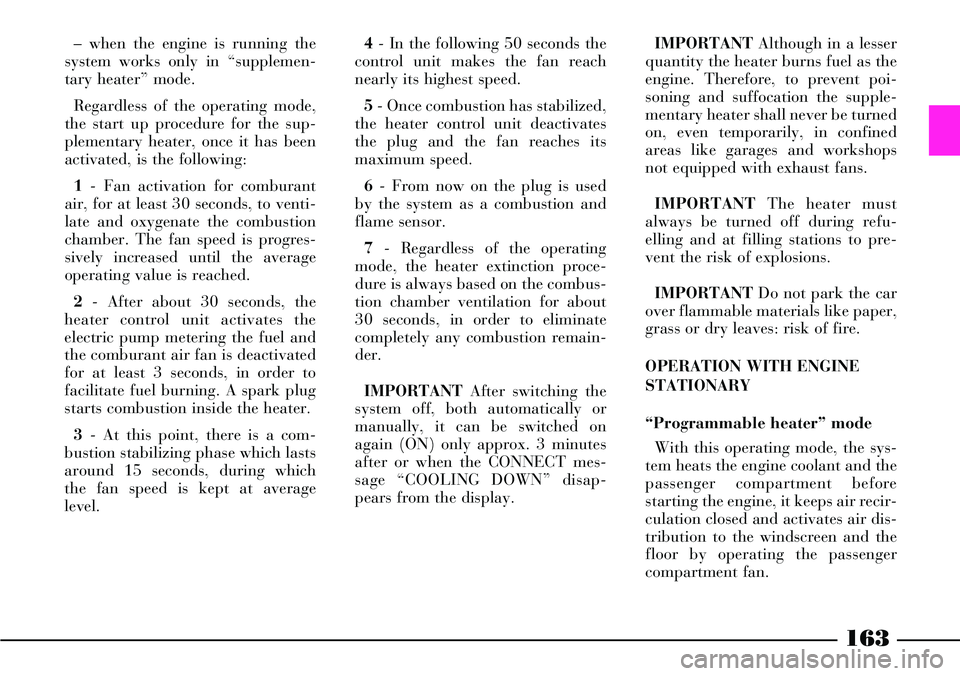
163
– when the engine is running the
system works only in “supplemen-
tary heater” mode.
Regardless of the operating mode,
the start up procedure for the sup-
plementary heater, once it has been
activated, is the following:
1- Fan activation for comburant
air, for at least 30 seconds, to venti-
late and oxygenate the combustion
chamber. The fan speed is progres-
sively increased until the average
operating value is reached.
2- After about 30 seconds, the
heater control unit activates the
electric pump metering the fuel and
the comburant air fan is deactivated
for at least 3 seconds, in order to
facilitate fuel burning. A spark plug
starts combustion inside the heater.
3- At this point, there is a com-
bustion stabilizing phase which lasts
around 15 seconds, during which
the fan speed is kept at average
level.4- In the following 50 seconds the
control unit makes the fan reach
nearly its highest speed.
5- Once combustion has stabilized,
the heater control unit deactivates
the plug and the fan reaches its
maximum speed.
6- From now on the plug is used
by the system as a combustion and
flame sensor.
7- Regardless of the operating
mode, the heater extinction proce-
dure is always based on the combus-
tion chamber ventilation for about
30 seconds, in order to eliminate
completely any combustion remain-
der.
IMPORTANTAfter switching the
system off, both automatically or
manually, it can be switched on
again (ON) only approx. 3 minutes
after or when the CONNECT mes-
sage “COOLING DOWN” disap-
pears from the display. IMPORTANTAlthough in a lesser
quantity the heater burns fuel as the
engine. Therefore, to prevent poi-
soning and suffocation the supple-
mentary heater shall never be turned
on, even temporarily, in confined
areas like garages and workshops
not equipped with exhaust fans.
IMPORTANTThe heater must
always be turned off during refu-
elling and at filling stations to pre-
vent the risk of explosions.
IMPORTANTDo not park the car
over flammable materials like paper,
grass or dry leaves: risk of fire.
OPERATION WITH ENGINE
STATIONARY
“Programmable heater” mode
With this operating mode, the sys-
tem heats the engine coolant and the
passenger compartment before
starting the engine, it keeps air recir-
culation closed and activates air dis-
tribution to the windscreen and the
floor by operating the passenger
compartment fan.
Page 165 of 386
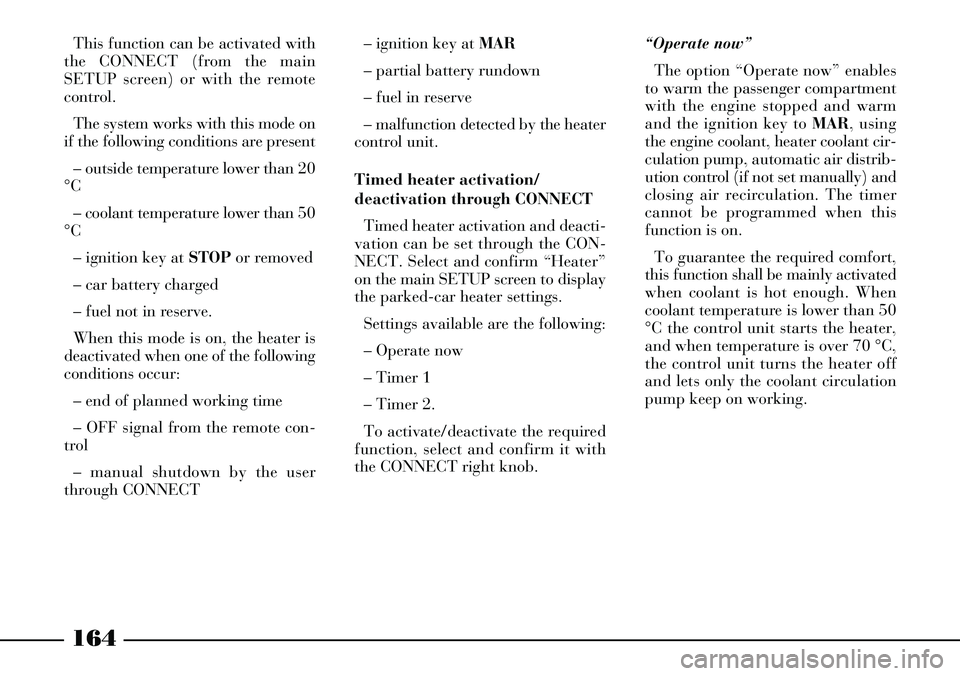
164
This function can be activated with
the CONNECT (from the main
SETUP screen) or with the remote
control.
The system works with this mode on
if the following conditions are present
– outside temperature lower than 20
°C
– coolant temperature lower than 50
°C
– ignition key at STOPor removed
– car battery charged
– fuel not in reserve.
When this mode is on, the heater is
deactivated when one of the following
conditions occur:
– end of planned working time
– OFF signal from the remote con-
trol
– manual shutdown by the user
through CONNECT– ignition key at MAR
– partial battery rundown
– fuel in reserve
– malfunction detected by the heater
control unit.
Timed heater activation/
deactivation through CONNECT
Timed heater activation and deacti-
vation can be set through the CON-
NECT. Select and confirm “Heater”
on the main SETUP screen to display
the parked-car heater settings.
Settings available are the following:
– Operate now
– Timer 1
– Timer 2.
To activate/deactivate the required
function, select and confirm it with
the CONNECT right knob.“Operate now”
The option “Operate now” enables
to warm the passenger compartment
with the engine stopped and warm
and the ignition key to MAR, using
the engine coolant, heater coolant cir-
culation pump, automatic air distrib-
ution control (if not set manually) and
closing air recirculation. The timer
cannot be programmed when this
function is on.
To guarantee the required comfort,
this function shall be mainly activated
when coolant is hot enough. When
coolant temperature is lower than 50
°C the control unit starts the heater,
and when temperature is over 70 °C,
the control unit turns the heater off
and lets only the coolant circulation
pump keep on working.
Page 166 of 386
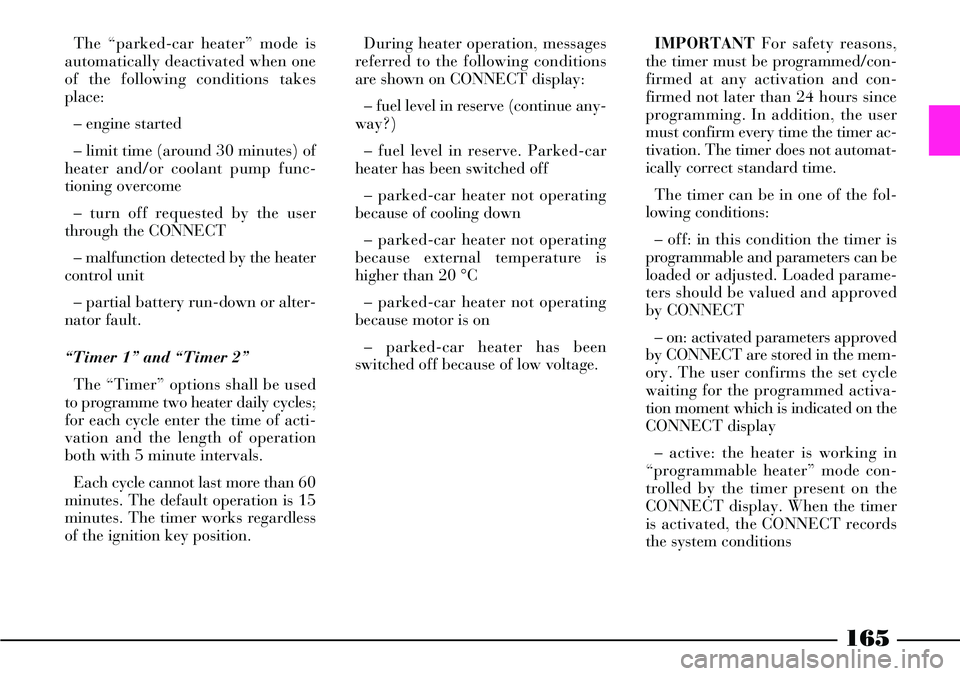
165
The “parked-car heater” mode is
automatically deactivated when one
of the following conditions takes
place:
– engine started
– limit time (around 30 minutes) of
heater and/or coolant pump func-
tioning overcome
– turn off requested by the user
through the CONNECT
– malfunction detected by the heater
control unit
– partial battery run-down or alter-
nator fault.
“Timer 1” and “Timer 2”
The “Timer” options shall be used
to programme two heater daily cycles;
for each cycle enter the time of acti-
vation and the length of operation
both with 5 minute intervals.
Each cycle cannot last more than 60
minutes. The default operation is 15
minutes. The timer works regardless
of the ignition key position.During heater operation, messages
referred to the following conditions
are shown on CONNECT display:
– fuel level in reserve (continue any-
way?)
– fuel level in reserve. Parked-car
heater has been switched off
– parked-car heater not operating
because of cooling down
– parked-car heater not operating
because external temperature is
higher than 20 °C
– parked-car heater not operating
because motor is on
– parked-car heater has been
switched off because of low voltage.IMPORTANTFor safety reasons,
the timer must be programmed/con-
firmed at any activation and con-
firmed not later than 24 hours since
programming. In addition, the user
must confirm every time the timer ac-
tivation. The timer does not automat-
ically correct standard time.
The timer can be in one of the fol-
lowing conditions:
– off: in this condition the timer is
programmable and parameters can be
loaded or adjusted. Loaded parame-
ters should be valued and approved
by CONNECT
– on: activated parameters approved
by CONNECT are stored in the mem-
ory. The user confirms the set cycle
waiting for the programmed activa-
tion moment which is indicated on the
CONNECT display
– active: the heater is working in
“programmable heater” mode con-
trolled by the timer present on the
CONNECT display. When the timer
is activated, the CONNECT records
the system conditions
Page 179 of 386

178
fig. 135
L0A0275b
fig. 134
L0A0274b
Fault indication
The system is controlled by an elec-
tronic control unit signalling possible
failures by turning on the s! warn-
ing light on the multifunction display
together with the message “EPB
FAULT - GO TO DEALER”.
For a higher safety, every time the
parking brake button is pressed dur-
ing a failure, a buzzer will sound to
draw the driver’s attention and the
xwarning light will turn on.
If the parking brake does not reach
the required working force (e.g.
when the battery is partially flat),
the instrument panel warning light
xstarts flashing.
In case of instrument panel warn-
ing light xfault, the s!warning
light on the multifunction display
turns on together with the message
“EPB INDICATOR FAULT - GO TO
DEALER” to informthe driver
about the dangerous situation. In case of failure indi-
cated by the related
warning light and mes-
sage turning on, drive carefully to
a Lancia Dealership because the
parking brake might not work.
Emergency disengagement
The electric parking brake is fitted
with an independent battery which
can be used to disengage the brake,
for instance when the car main bat-
tery is completely flat or it has bro-
ken after an accident.The additional battery, always
kept charged by a dedicated elec-
tronic control unit, can engage and
disengage the parking brake when it
is necessary to push manually the
car.
To engage and disengage the elec-
tric parking brake when the car
main battery is completely flat, turn
the key to MARand press the main
button on the central console.